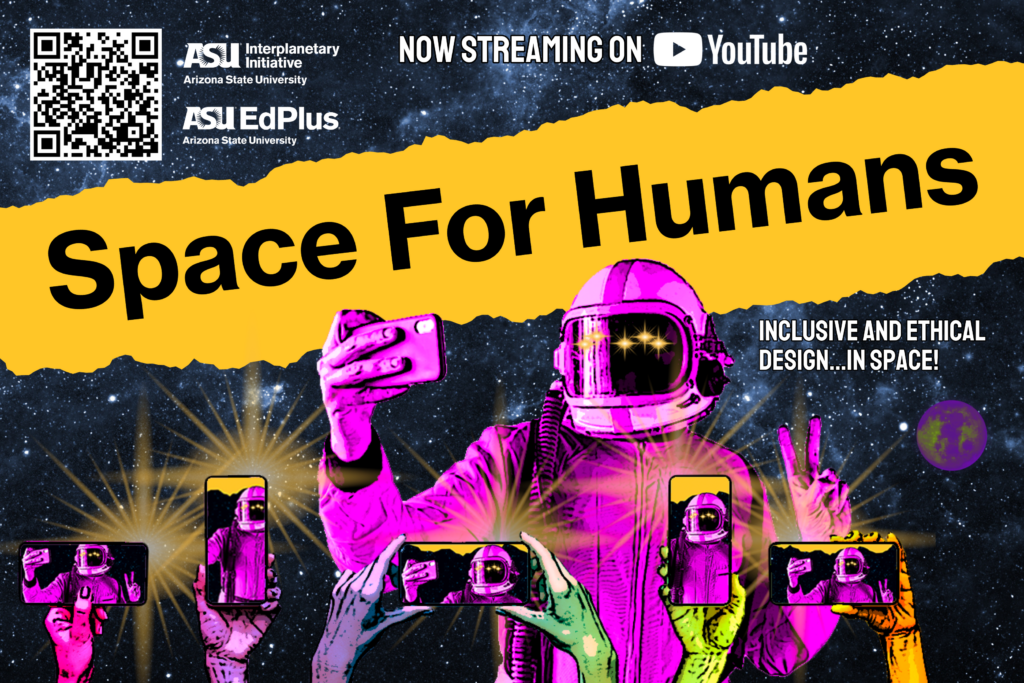Designing inclusive futures both in space and on Earth
The ASU Interplanetary Initiative has launched an exciting new YouTube channel focused on how space activities are transforming our world. This channel is part of Interplanetary Initiative’s pilot project, Space Exploration and Sustainable Development, led by Dr. Eric Stribling. A collaboration with EdPlus at ASU, this educational series titled Space for Humans, explores topics surrounding inclusive and ethical design in space.
We interviewed Dr. Stribling and several students featured in the current Space for Humans videos to learn about their involvement and what this project means for inclusive design of our space future. Read on to discover the main message behind the channel, the reasons for its creation, the importance of its content, and how students play a crucial role in sharing this information.
We began by asking Dr. Stribling the following questions around the purpose of the channel.
What is Space for Humans?
Space for Humans is a YouTube-first channel focused on the impacts of human expansion in space on society. In our first season, we have had a dual focus. We have a large collection of 3-min videos that create awareness on how space technologies have impacted life back on Earth, and then we have longer 10-min videos that dive deeper into the design of these technologies and how they may be impacting different stakeholder groups (often unintentionally). The goal is to drive awareness and discussion around issues important to the design and implementation of space technologies for the benefit of humans.
Who is the team behind Space for Human? Why do you feel it’s important to prominently feature students’ voices?
This has been a collaboration between EdPlus for the video production, myself and other members of Interplanetary Initiative for the research, Amanda Kehrburg a PhD student from Cronkite School of Journalism for scriptwriting, and then a large team of mostly undergraduate researchers. We did want to be intentional about including students, not only because it’s a good experience for them, but also because our target audience includes undergraduate students, and it’s much easier oftentimes to learn from your peers.
Why do you feel like Space for Humans is a needed resource in today’s world, and what inspired this format?
The space sector is still relatively young, especially the commercial side; however, it is scaling rapidly, so there are a couple of years where we can discuss the design and business models of technologies, at an early stage, so that these technologies are more likely to maximize the positive benefits to human society. We have been working on publishing largely academic articles to this point, and so we see popular scholarship as important at this stage for achieving our larger goals of driving positive change. We’ve spent the last several years researching the impacts of the space industry on issues of environmental and social sustainability, and launching this channel is a great way to move some of that research into the public sphere to hopefully drive dialogue around these important issues.

Our student voices were Matthew Marquez, an ASU 2024 graduate with a Bachelor of Science in Technological Leadership from the Interplanetary Initiative, Kennedy Gourdine, a rising senior at ASU pursuing a B.A. in Sustainability with a minor in urban planning, and Lindsey Tober, an Interplanetary Initiative Technological Leadership junior, with a film and media production minor. Below, they share their experience with this project.
Tell us briefly why you each wanted to be involved in this project?
Matthew: We had a bit of an inside scoop on the project with my involvement with Eric. Lindsey’s team had reached out to the ASU Space Student Ambassadors asking for scripts and I had some ideas from my Inquiry class from Tech Leadership that made the cut!
Kennedy: I wanted to be a part of this project because it was a great opportunity to learn more about transformative space technology and share it in a creative way. I’ve never made a Youtube video before but I had so much more fun doing this than writing a paper!
Lindsey: I was so incredibly excited to be a part of this project because it’s exactly what I want to do when I am older – space communications. This project gave me the ability to mix my love of space and my love of filmmaking together. I get to work on almost every part of production as well, which allows me to learn so much.
As a student and space enthusiast, what does Space for Humans get right and what else could it deliver?
Lindsey: I definitely wish there was more content like Space For Humans! The space community needs to be more vocal about creating inclusive and ethical designs for space. It’s also a good reminder to people about the mass effects space technologies have on our daily lives. Hopefully it can lead to more support for space science.
Matthew: I wish there was maybe a history section? A video on the 2019 crashing of Tardigrades on the moon (Extremophiles, organisms that can survive in a vacuum or extreme environments) would be great! This is purely because I am a history buff and I think there are a lot of stories to share.
What impact do you hope Space for Humans will have on society?
Lindsey: Content like Space For Humans contributes to creating awareness for ethical and inclusive designs when going to space. It helps get the conversation going about how our design choices impact real people. It’s incredibly important to the future of space because we want space to be a place for all, not just for “reference man”. Changing our designs today could help us create a more inclusive and diverse community in space and on Earth.
–
Now that you’re well versed in understanding Space for Humans, head over to the channel, hit subscribe and never miss a new video!